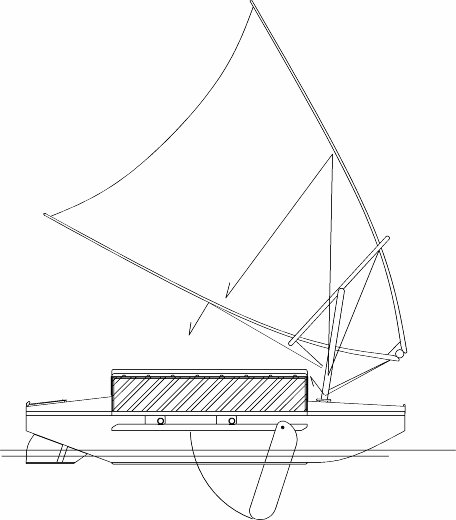|

Intro
to Trilobyte 16
Get OUT there! Travel to a cruising area of choice, slam together an expedition-cruiser in a week or less, and go play. That’s the driving scenario behind the design of Trilobyte 16. Every effort has been made to streamline materials and construction details to minimize building time and maximize playtime. If you are a couple handy with tools and not hung up on finish, Trilobyte 16 can be built in three long days. Depending on choices and skills, it could take up to a week. What’s Special about Trilobyte 16? Many of the best recent innovations in small boat design have been incorporated into Trilobyte 16. The synergies between them yield an extraordinary return on a minimal investment in construction time and materials. Phil Bolger introduced a true revolution in micro-cruiser design with his Birdwatcher concept. A watertight, transparent super-structure is built upwards from the sheer of an ultra-shoal-draft hull. Decks continue the water-tight integrity inboard to an elongated mid-ships companionway (which may be covered by removable fabric and/or hatches). This allows sailing with very little fixed ballast, taking any knock-downs in stride by floating on the high topsides. Self-rescue is accomplished from inside the boat! All-round windows give excellent visibility, and all ship-handling may be done from below-decks. The inherent safety advantages of this approach are manifold, especially when cruising cold waters. Camper shelter is inherent whether at anchor or hauled out ashore (no set-up of dodgers or tents necessary). Bolger and others (notably Jim Michalak) have used this approach in designs ranging from micro- to deep-water cruisers. A last requirement peculiar to small, oar auxiliary boats of Birdwatcher lineage is that the “rig be quick enough to strike that one is not tempted to row with it standing.” The foundation for Trilobyte 16 is a hull (up to the sheer) based on barge lines. This is a departure from the more common sharpie lines which have a ‘rockered’ (curved) bottom as seen in profile view. A barge’s flat mid-run maximizes displacement and form stability. Transoms are run high to clear the water while heeled and establish a short, upright waterline (which makes for agile tacking). The cabin benefits by constant headroom (doesn’t taper down at one or both ends) over a flat plane (you don’t have to choose between sleeping/living on a curve vs. building a platform). Even better, layout and construction are radically simplified. In Trilobyte 16 I’ve taken the K.I.S.S. principle (Keep It Simple, Stupid!) to extremes by conforming all major components (hull, cabin, decks, bulkheads and transoms) to simple fractions of plywood dimensions (8, 4, 2, 1 feet). The constant, four foot, zero-flare beam means that ply sheets may be used at full width, eliminating all edge cuts and chine bevels. In consequence, materials layout and cutout are reduced to the bare minimum, and structure is self-rectifying (if the edges meet, everything is square and true). Trilobyte 16 is designed around its cabin. It’s 4 feet wide, 3 feet 4½ inches of sitting headroom (more under the full length companionway) and 7 feet 10 inches long. This is plenty for two adults of moderate beam. A third adult, or the equivalent in kids and/or dogs, may be accommodated by sleeping staggered. There is ample storage in the bays outboard of the bulkheads. Matt Layden has used chine runners on several successful small cruisers in the ‘two ply sheets of length’ range. He has some amazing voyages under his belt ranging from Nova Scotia to the Bahamas. Chine runners provide lateral resistance without increasing depth by increasing the efficiency of the hull’s lateral plane. Trilobyte 16’s barge lines, with their flat run amidships, eliminate drag produced by the runners following a rockered bottom. They make a handy boarding step and a ready made slot-board for the small off-centerboard. Trilobyte 16's are specified below the actual chine (attached to the bottom) to double as skids and to form a ‘rabbet’ which simplifies the hull assembly. Unfortunately, the prototype demonstrated that the Chine Runners lose their grip when tacking as the light, high-windage hull goes upright and loses way. A small Off-Centerboard has been added to compensate. Motivation is primarily sail and oar, but a motor may be fitted. Trilobyte 16 is an ‘open-rig’ design, i.e., experimentation and adaptation are actively encouraged. BUT... ‘Blondie’ Hasler and Scott McLeod coined the term automatic for sails that can be manipulated solely by running rigging (‘hands-off’). Choice of such a rig completes the below-decks qualities of the Birdwatcher approach. To me, the most exciting of the automatic rigs is a recent modification of the Polynesian Crab Claw Rig. The sail is highly efficient despite its unmodified flat-cut (very easy to make). See its Sail Plan and Appendix I for details. Other automatic rigs include variations of the Hasler Junk, Bolger and Friend’s Chinese Gaff, Layden Roller Lug and Ljungstrom rigs. The sum of these ideas is truly greater than the parts. I believe
that the synergies underlying Trilobyte 16 make possible a kind
of adventure that has been closed to accommodation cruisers. Whether
built at home or in the field, by beginners or old hands, Trilobyte
16 affords a premium return on investment in time and materials.
I sincerely hope that you have as much fun with yours as we’re
having / gonna have with ours!
|